Understanding cake size and serving guides ensures your dessert meets guest expectations. Factors like tiered cakes, slice dimensions, and event type influence serving calculations. Proper planning guarantees everyone enjoys a fair share.
Importance of Proper Cake Sizing
Proper cake sizing is crucial for ensuring every guest enjoys a fair and satisfying portion. Whether it’s a party, wedding, or special occasion, accurately determining cake size prevents waste and ensures no one is left without a slice. Understanding serving guidelines allows hosts to budget effectively and cater to diverse appetites. For events, sizing affects both presentation and guest satisfaction, making it essential to align cake dimensions with the number of attendees. Proper sizing also helps in maintaining consistent flavor and texture across all servings. By adhering to established serving charts, you can create a memorable and enjoyable experience for everyone involved.
Understanding Standard Serving Sizes
Standard serving sizes are essential for accurately determining how much cake each guest will receive. Typically, a party serving is based on slices measuring 1×2 inches, while wedding servings may be slightly larger or more generously portioned. Round cakes, such as 6-inch, 8-inch, and 10-inch, have established serving capacities, with a 6-inch cake serving 8-12 people, an 8-inch serving 14-24, and a 10-inch serving up to 38. Sheet cakes also follow specific guidelines, with small sheet cakes serving 12 and large ones serving 40 or more. Understanding these standards helps in selecting the right cake size for any event, ensuring everyone gets an equal and satisfying portion without excess or shortage.

Different Cake Sizes and Their Servings
Cake sizes vary to accommodate different gatherings, with 6-inch cakes serving 8-12, 8-inch serving 14-24, 10-inch up to 38, and 12-inch for larger events, ensuring optimal portion distribution.
6-Inch Cakes: Servings and Uses
A 6-inch cake is ideal for small gatherings, serving 8-12 people with standard 1×2-inch slices. Perfect for intimate events like birthdays or anniversaries, it offers versatility in decorations and flavors. Its compact size makes it easy to transport and display, while still providing ample portions for a cozy celebration. Layered 6-inch cakes can also be created for added visual appeal without sacrificing serving capacity, making them a practical choice for hosts seeking elegance on a smaller scale.
8-Inch Cakes: Servings and Cutting Styles
An 8-inch cake typically serves between 14 to 28 people, depending on slice size and cutting style. For event-style servings, slices are often thinner, allowing up to 24 portions. Classic servings yield 14-16 generous slices. This size is versatile, suitable for both small and medium-sized gatherings. Event-style cutting is ideal for larger events, while thicker slices are better for intimate celebrations. The 8-inch cake is a popular choice for its balance of size and serving capacity, making it a dependable option for various occasions.
10-Inch Cakes: Servings and Event Recommendations
A 10-inch cake is an excellent choice for medium to large gatherings, serving 21 to 38 people depending on slice size. Generous slices can accommodate up to 12 guests, while thinner cuts increase the serving count. This size is ideal for birthday parties, anniversaries, and corporate events. Event-style cutting allows for more servings, making it suitable for larger audiences. The 10-inch cake strikes a balance between elegance and practicality, ensuring ample portions for various celebrations. Its versatility makes it a go-to option for hosts seeking a cake that impresses both in appearance and serving capacity.
12-Inch Cakes: Servings and Large Gatherings
A 12-inch cake is perfect for large gatherings, providing generous servings for up to 48 guests with standard slices. Thinner cuts can increase the serving count, making it ideal for events like weddings, corporate functions, or community celebrations. This size is versatile, offering ample portions while maintaining an impressive presentation. For large events, pairing a 12-inch cake with smaller complementary desserts or sheet cakes ensures variety and meets diverse preferences. Proper planning is essential to avoid waste, as the cake’s size demands strategic slicing and serving strategies. A 12-inch cake is a reliable choice for hosting sizable groups, ensuring everyone enjoys a satisfying portion.

Event-Specific Cake Serving Guidelines
Understanding event-specific cake serving guidelines is crucial for ensuring adequate portions at gatherings. Party and wedding settings often require different slice dimensions and quantities. Adjusting slice sizes based on the occasion ensures everyone receives a fair share, making your event planning seamless and stress-free.
Party Serving Sizes: Slice Dimensions and Quantity
For parties, standard serving sizes are typically based on slices measuring 1×2 inches. A 6-inch cake serves 12 people, while an 8-inch cake serves up to 24. A 10-inch cake can serve 36 guests, and a 12-inch cake accommodates larger gatherings with up to 48 slices. These dimensions ensure consistent portioning, making it easier to plan for events. Thin slices maximize servings, while slightly thicker cuts may reduce the total number but offer more generous portions. Using a cake serving chart can help determine the ideal size and slice count for your event, ensuring everyone enjoys a fair share without waste.
Wedding Serving Sizes: Portion Guidelines
Wedding cake serving sizes often follow specific portion guidelines to ensure generous yet consistent servings. Typically, wedding slices are slightly larger than party slices, measuring around 1.5×2 inches. An 8-inch wedding cake can serve 24-28 guests, while a 10-inch cake serves 38-45 people. For larger weddings, a 12-inch cake provides 50-60 servings. Wedding servings are calculated based on the cake’s volume, divided by the standard serving size of 1×2 inches. Proper planning ensures every guest receives an equal and satisfying portion, making your wedding dessert memorable and enjoyable for all attendees.
Different Occasions: Adjusting Slice Sizes
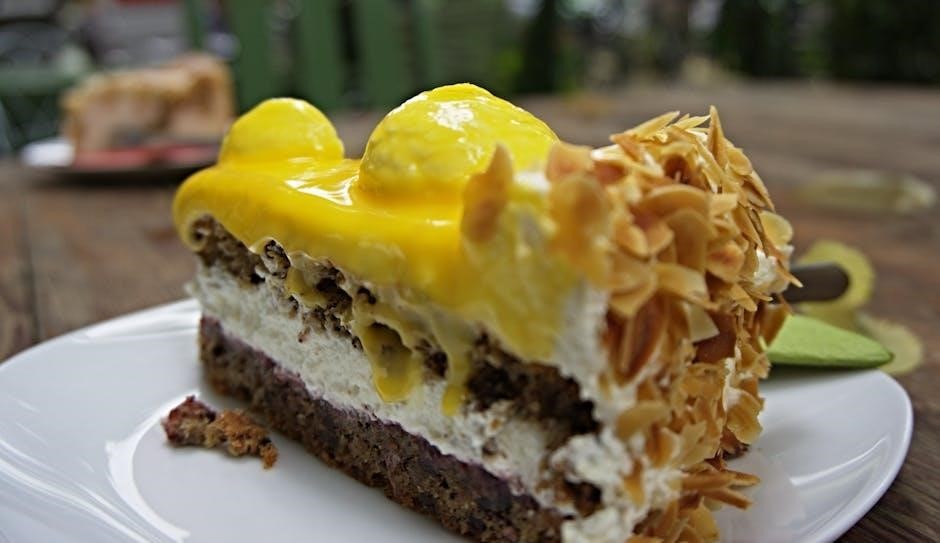
Different events call for adjusting cake slice sizes to match the occasion’s needs. For casual gatherings, thinner slices (1×2 inches) maximize servings, while formal events may require larger portions (1.5×2 inches). Weddings often use standard wedding slices, but parties might opt for smaller cuts to ensure everyone gets a taste. Adjusting slice sizes allows hosts to balance guest numbers and portion preferences. For example, a 10-inch cake can serve up to 24 people with event-style cuts or 12 people with generous slices. Flexibility in slice sizing ensures the cake meets the event’s demands, whether it’s a intimate celebration or a grand affair.

Layer Cake Size and Serving Guide
Layer cakes vary in size and servings, with 5-inch cakes serving 6-8 people, 7-inch serving 14-28, and 9-inch serving 21-38; Sizes cater to different gatherings.
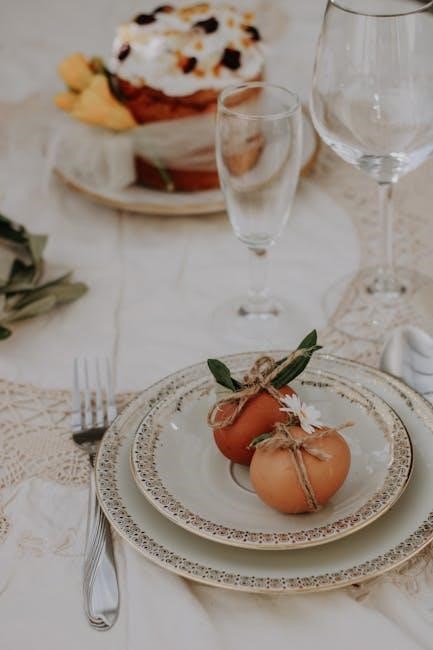
5-Inch Layer Cakes: Serving Capacity
A 5-inch layer cake is ideal for small gatherings, serving 6 to 8 people. Its compact size makes it perfect for intimate events or as a top tier in a wedding cake. The smaller diameter allows for thinner slices, ensuring each guest receives a balanced portion without excess. This size is great for precise portion control and is often used in tiered setups for visual appeal. It’s a popular choice for dessert tables or when serving individual-sized treats. The 5-inch cake’s serving capacity is versatile, catering to both casual and formal events with ease. Its manageable size also simplifies transportation and display.
7-Inch Layer Cakes: Serving Recommendations

A 7-inch layer cake is a versatile option, typically serving 10 to 14 people, depending on slice size. Its moderate size makes it ideal for small to medium gatherings, such as birthdays or intimate weddings. Standard slices are usually 1 inch wide and 2 inches deep, providing generous portions. This size is popular for tiered cakes, often used as a middle layer to balance aesthetics and servings. It’s also a great choice for events requiring precise portion control. The 7-inch cake’s serving capacity ensures everyone gets a fair share without excess. Its compact yet hearty size makes it a practical and elegant choice for various celebrations.
9-Inch Layer Cakes: Servings and Uses
A 9-inch layer cake typically serves 16 to 20 people, depending on slice size and event style. Its generous proportions make it ideal for larger gatherings, such as weddings or corporate events. Standard slices are often 1.5 inches wide and 2 inches deep, providing hearty portions. This size is popular for tiered cakes, frequently used as the base layer to accommodate more guests. It’s also a versatile option for standalone desserts, offering enough servings for substantial events. The 9-inch cake’s size ensures it can be easily divided into even portions, making it a reliable choice for celebrations requiring ample servings without compromising on presentation or taste.
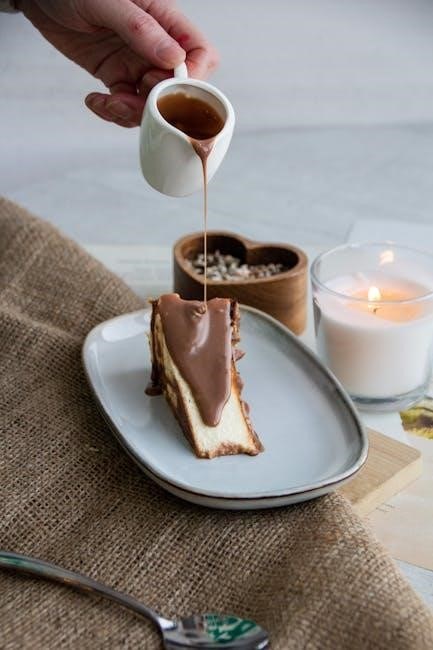
Sheet Cake Size and Serving Guide
Sheet cakes are popular for large events, offering generous servings. A large sheet cake typically serves 40-50 people, with a standard size of 18×24 inches. They are ideal for easy serving and consistent slice sizes, making them perfect for both casual and formal gatherings.
Large Sheet Cakes: Servings and Dimensions
Large sheet cakes are ideal for big gatherings, offering substantial servings. A standard large sheet cake measures 18×24 inches, typically serving 40-50 people. The dimensions allow for uniform slicing, ensuring each guest gets an equal portion. These cakes are commonly used for weddings, corporate events, and large parties due to their efficiency. The serving size is usually 1×2 inches per slice, making it easy to plan for any event. This size is versatile and fits well in both casual and formal settings, providing ample dessert for your guests without unnecessary leftovers.
Small Sheet Cakes: Servings and Event Suitability
Small sheet cakes are perfect for intimate gatherings, offering 12-15 servings. Measuring around 9×13 inches, they provide generous 1×2-inch slices. Ideal for small parties, birthdays, or office events, these cakes are easy to serve and transport. Their compact size makes them suitable for casual settings without sacrificing flavor or presentation. The smaller portion ensures minimal waste, making them a practical choice for events with fewer guests. Their versatility allows for customization, fitting various themes and dietary preferences. Whether for a family celebration or a small corporate function, a small sheet cake delivers both convenience and satisfaction, ensuring everyone enjoys a delicious treat.
Tools for Determining Cake Size
Use cake serving charts, online calculators, and tiered cake calculators to determine the perfect size. These tools help calculate servings, choose appropriate sizes, and customize for events.
Using a Cake Serving Chart
A cake serving chart is an essential tool for determining the right cake size for any event. It provides detailed information on how many servings each cake size can yield, based on standard slice dimensions. For example, a 6-inch cake typically serves 12 people, while an 8-inch cake can serve up to 24. These charts also differentiate between party and wedding servings, with party slices measuring around 1×2 inches and wedding slices slightly larger. By referring to a cake serving chart, you can avoid underestimating or overestimating the number of guests. This ensures everyone gets a fair share and reduces waste. Printable charts are widely available online for easy reference.
Online Cake Size Calculators
Online cake size calculators are handy tools that help determine the perfect cake size for any event. These calculators allow users to input the number of guests and preferred slice size to receive tailored recommendations. Many calculators differentiate between party servings (1×2 inches) and wedding servings (larger slices). By entering the event type and guest count, you can instantly find the ideal cake dimensions. This saves time and reduces the risk of overestimating or underestimating servings. Some calculators also provide options to adjust for tiered cakes or multiple layers. They are user-friendly, accessible, and ensure precise planning for any celebration, making them a valuable resource for hosts and bakers alike.
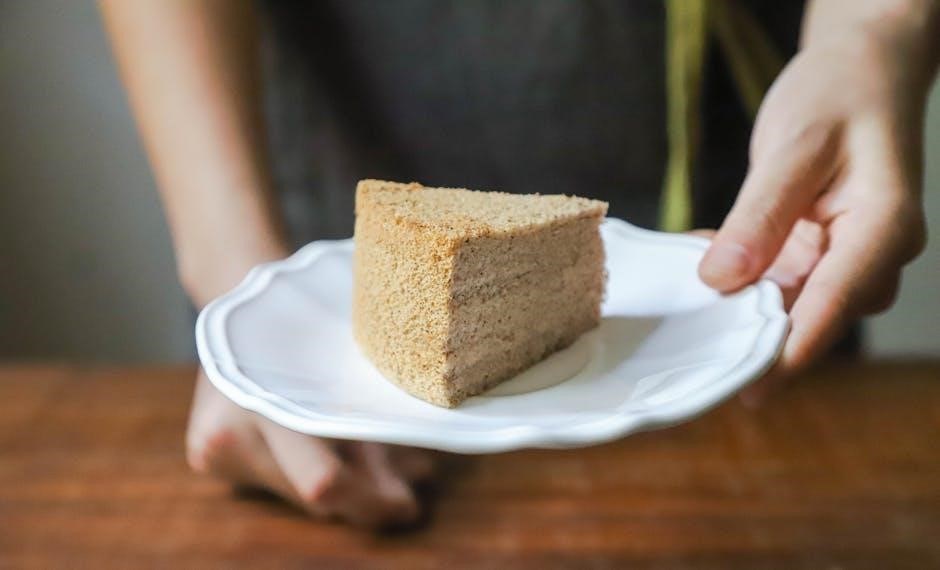
Practical Tips for Cutting Cakes
Use sharp tools for clean cuts and even slices. Measure slices based on event type, with party slices at 1×2 inches and wedding slices larger. Techniques like crumb-coating and chilling can help achieve precise portions, ensuring every guest enjoys a consistent serving size without waste.
Maximizing Servings with Thin Slices
Thin slices are a practical way to maximize servings from a cake. Use a serrated knife to make clean, even cuts. Chilling the cake briefly can firm it, making slicing easier. For thin slices, aim for 1-inch widths and 2-inch depths, doubling the number of servings. This method works well for large gatherings or events where smaller portions are preferred. Ensure slices are uniform to maintain consistency. Consider serving thin slices with toppings or sides to enhance satisfaction without increasing portion sizes. This technique is especially useful for sheet cakes and layer cakes, ensuring everyone gets a taste. Proper cutting tools and techniques are key to achieving thin, even slices.
Cutting Techniques for Event-Style Servings
Event-style servings often require precise cutting techniques to achieve consistent, visually appealing slices. For round cakes, start by cutting a central circle, then slice outward in radial lines. This method ensures uniform portions and maximizes the number of servings. For sheet cakes, use a grid pattern based on the desired slice dimensions. A serrated knife or cake cutter is ideal for clean cuts. Chill the cake to firm the layers, making it easier to slice without crumbling. Measure each slice to maintain consistency, especially for weddings or formal events where presentation matters. Proper training and tools can enhance efficiency and professionalism when cutting large quantities of cake.
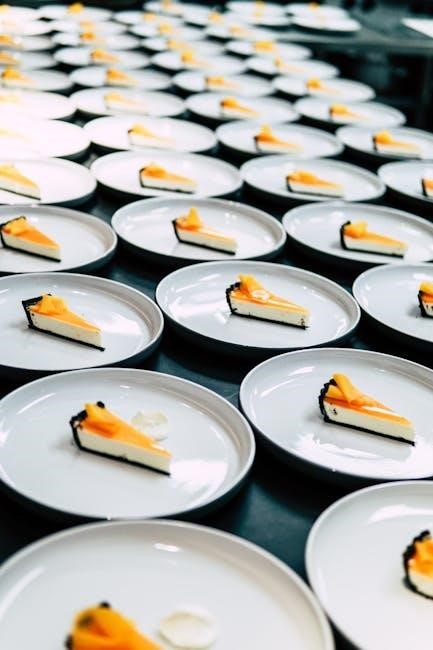
Common Mistakes in Cake Serving
Common mistakes include underestimating serving sizes, leading to insufficient slices, and overestimating, resulting in leftover cake. Using a cake serving chart or calculator helps avoid these errors.
Underestimating Serving Sizes
Underestimating serving sizes is a common mistake that can lead to insufficient cake for guests. This often occurs when the cake size is too small for the number of attendees or when slices are cut larger than planned. For example, an 8-inch cake intended for 24 people might only yield 18 slices if cut generously. This discrepancy can result in some guests receiving smaller portions or missing out entirely. To avoid this, use a cake serving chart or calculator to determine the appropriate cake size based on guest count and desired slice dimensions. Proper planning ensures everyone enjoys a fair and satisfying portion of cake at your event.
Overestimating Slice Sizes
Overestimating slice sizes is a frequent error that can result in fewer servings than anticipated. For instance, an 8-inch cake might serve only 14-16 people if slices are cut too large, despite its potential for 24 servings. This miscalculation often stems from assuming larger portions will satisfy guests, but it risks leaving some without cake. To prevent this, use a cake serving chart or calculator to determine the correct cake size based on guest count and desired slice dimensions. Additionally, cutting slices uniformly and on the thinner side can maximize servings while maintaining portion satisfaction. Proper planning ensures your cake meets everyone’s expectations without unnecessary waste or disappointment.
Proper cake size planning ensures happy guests and memorable events. Use guides, tools, and techniques to avoid mistakes and create perfectly portioned desserts for every celebration.
Final Thoughts on Cake Size Planning
Accurate cake size planning is crucial for ensuring every guest enjoys a fair and satisfying portion. By considering factors like slice dimensions, event type, and appetite, you can avoid common mistakes. Utilize tools such as serving charts and calculators to determine the ideal cake size. Whether it’s a party, wedding, or gathering, proper planning ensures your dessert is both memorable and plentiful. Remember, precision in cake sizing enhances the overall experience, making your event a success. Always double-check your calculations and adjust based on specific needs. This thoughtful approach guarantees happiness for both hosts and guests alike.
Additional Resources for Cake Serving Guides
For further assistance, explore online resources like cake serving charts, calculators, and guides. Websites offer detailed sizing charts, such as the Classic Cakes Sizing Chart, which provides serving capacities for various cake sizes. Pinterest boards, like “Cake Serving Charts,” showcase visual guides for planning. Printable charts and downloadable tools help simplify the process. Additionally, many bakeries and event planning websites share tips on adjusting slice sizes based on the occasion. Utilize these resources to ensure accurate calculations and stress-free planning for your events. These tools offer practical insights and customizable solutions to match your specific needs, ensuring your cake serves the perfect number of guests.